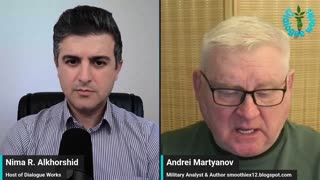Premium Only Content

Episode 1854: Are the conciliar hippies of the Church bringing back Archaeologism?
What we have seen from the conciliar church of VII is that the hippies came in young and did radical things ousting the wiser and more traditional elements of the church. They said things like Ogornamentium (change) and what we saw from these young hippy church officials is the same thing we see from them now that they are old hippies. Change and more change. What’s the real plan of these modernist conciliar old hippies? Before they die they will make sure the church dies with them. It’s all or nothing and that’s the sign of communism within the church.
But what have I told you in the past episodes? Nothing new under the sun! These old hippies resurrect the same heresy’s of old and they dust them off for the unsuspecting faithful and they preach them all over again.
Okay so you may ask what the heresy is you speak of Walt.
What is Archaeologism? Aar-kee-aa-lugism
Archaeologism, sometimes called "antiquarianism," refers to a tendency within the Catholic Church to overemphasize the practices and structures of the early Church, particularly the patristic era (2nd-8th centuries). Proponents advocate for a return to these practices, believing them to be purer and closer to the ideal set by Christ and the Apostles. They often view later developments and reforms with suspicion, considering them deviations from the original model.
Key Characteristics:
Exalting the Past: Emphasis on early Church practices as normative and superior to later developments.
Strict Adherence to Antiquity: Preference for historical forms of liturgy, structures, and even language.
Suspicion of Reform: Resistance to changes implemented by the Church after the early centuries, seeing them as departures from tradition.
Focus on Textual Interpretation: Preference for literal interpretations of early Christian writings for liturgical and theological matters.
Criticisms and Concerns:
Misunderstanding of Tradition: Tradition in Catholicism is seen as a living stream, not a museum exhibit. It evolves organically, guided by the Holy Spirit, while remaining rooted in its origin. Archaeologism potentially neglects this organic development.
Rigidity and Ahistoricity: The early Church faced different challenges and contexts than today. Rigidly applying its practices without adaptation might not be pastorally relevant or even feasible.
Ignoring Valid Developments: The Church has developed theological and liturgical understanding over time through reflection and scholarship. Archaeologism might neglect valuable insights gained through this process.
Risk of Division: Emphasizing only a specific period in history can create tensions and divisions within the Church by neglecting the diversity of legitimate expressions of faith throughout its history.
Additional Points:
Pope Pius XII in his encyclical "Mediator Dei" (1947) warned against archaeologism, advocating for a "true and organic restoration" that considers both historical origins and current needs.
The Second Vatican Council (1962-1965) called for a renewed engagement with Scripture and liturgical practices while emphasizing continuity with tradition.
The debate continues among theologians, liturgists, and laity, highlighting the complexity of navigating the Church's history and adapting its practices for the sake of its mission.
Advocates of traditional Latin Mass often cite concerns about losing connection to the Church's historical liturgical heritage due to reforms and emphasize the value of preserving elements from the earlier Church.
Arguments Against Archaeologism Influence:
Many scholars argue that Vatican II reforms aimed for a "renewal" rather than a strict return to the past. They emphasize the Council's focus on adapting liturgy to contemporary culture and fostering greater participation by the faithful.
Proponents of the reforms cite the need for the Church to remain relevant and engage with current needs. They argue that blindly copying ancient practices would not necessarily serve the faith community effectively in the modern world.
While Archaeologism was not officially declared heretical, its influence on the Catholic Church after Vatican II has drawn criticism for several potential negative aspects:
1. Alienation and Confusion:
Strict adherence to ancient forms, unfamiliar to many modern Catholics, could create a sense of alienation and hinder engagement with the liturgy.
Emphasis on specific historical eras might neglect the richness and diversity of the Church's tradition throughout history, causing confusion and a lack of connection to broader Catholic heritage.
2. Difficulty in Implementation:
Implementing archaic practices without adaptation to modern contexts could be impractical and even create liturgical inconsistencies.
Rigid interpretations of historical documents might not translate well to contemporary cultural norms and sensibilities, potentially hindering effective communication of the Church's message.
3. Risks of Division and Exclusion:
Overemphasis on specific historical periods can create tension and division within the Church, pitting traditionalists against those embracing change.
Focusing solely on practices associated with a limited historical period might exclude the diverse forms of Catholic expression across cultures and eras.
4. Oversimplification of Tradition:
Archaeologism can lead to a simplistic understanding of tradition as static and unchanging, neglecting its organic development and adaptation throughout history.
It might downplay the ongoing role of the Holy Spirit in guiding the Church's evolution and its ability to respond to new challenges and contexts.
5. Limited Theological Engagement:
Strict adherence to ancient interpretations might discourage critical theological reflection and engagement with contemporary interpretations of Scripture and tradition.
It could foster a reliance on past authorities over contemporary scholarship and dialogue, potentially hindering theological progress and adaptation.
St. Ignatius and Tradition:
Emphasis on Unity: Ignatius prioritized the unity of the Church above all else. He saw faithfulness to the teachings of the Apostles and unity under the bishop as crucial for maintaining this unity.
Tradition as Transmission: He understood tradition as a transmission of the Apostles' teachings through word and practice, passed down faithfully throughout generations.
Discernment within Tradition: While valuing tradition, Ignatius was not blindly conservative. He warned against false teachings disguised as tradition, urging discernment and adherence to the true apostolic deposit.
Christ as Foundation: The ultimate foundation for him was not simply past practices, but Jesus Christ himself. He saw tradition as rooted in Christ's teachings and serving as a guide for the Church's life.
Examples from his Letters:
"Be subject to the bishop and to the presbytery... Let no man do anything apart from the bishop... It is good to obey God and the bishop." (Letter to Smyrnaeans)
"Flee therefore false teachings, as you would wild beasts... Whoever corrupts the words of the Lord Jesus Christ to suit his own desires has condemned himself, not me." (Letter to Magnesians)
"Therefore, he who does not confess that Jesus Christ came in the flesh is antichrist; and whoever does not confess the witness of the cross is the devil." (Letter to Trallians)
-
 1:49:48
1:49:48
Dear America
3 hours agoTrump Has HISTORICAL Meeting With PUTIN! Now Trump Is Meeting Zelenskyy! IS PEACE HERE?!
71.5K40 -
 2:06:30
2:06:30
Matt Kohrs
11 hours agoMarket Open: BIG Moves Incoming?!?! || Live Trading
10.9K2 -
 LIVE
LIVE
JuicyJohns
2 hours ago $2.67 earned🟢#1 REBIRTH PLAYER 10.2+ KD🟢
167 watching -
 44:07
44:07
The Quiet Part
2 hours agoThey Fear People Who Remember—The Truth About Freedom, Health Care & Canada
1.05K1 -
 LIVE
LIVE
Wendy Bell Radio
6 hours agoDemocrats Are In Total Free Fall
7,576 watching -
 54:23
54:23
Dialogue works
2 days ago $1.25 earnedAndrei Martyanov: Putin Beating Trump at His Own Game - Can Israel Survive a War W/ Iran W/o the US?
21.1K8 -
 58:23
58:23
JULIE GREEN MINISTRIES
4 hours agoJUDGEMENT IN DC IS ABOUT TO INTENSIFY
98.3K199 -
 1:27:39
1:27:39
Chicks On The Right
5 hours agoTrump & Putin Summit, Newsom’s 2028 Dreams, and Kamala's Drunk Rant | Chicks on the Right
27.3K4 -
 2:02:30
2:02:30
Welcome to the Rebellion Podcast
21 hours ago $1.36 earnedA Case of the MonJays - WTTR Podcast Live 8/18
27.6K1 -
 4:01:59
4:01:59
The Bubba Army
3 days agoZelensky SLAMS Trump-Putin Meeting - Bubba the Love Sponge® Show | 8/18/25
44.9K12